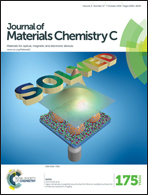First-principles prediction of inversion-asymmetric topological insulator in hexagonal BiPbH monolayer†
Abstract
Band topology and Rashba spin splitting (RSS) are two extensively explored yet exotic properties in condensed matter physics. Nonetheless, their coexistence has rarely been achieved in simple stoichiometric two-dimensional (2D) ultrathin films. Here we use first-principles calculations to predict a new inversion-asymmetric BiPbH monolayer, which allows for the simultaneous presence of nontrivially topological order and large RSS. Interestingly, the coexistence of the topological band gaps and RSS in this system are robust and stable over a wide range of strain (−6 to 6%), with the maximum bulk gap being enhanced to 0.40 eV and Rashba energy as large as 53.1 meV under achievable strains, respectively, which makes them viable for practical realization of the QSH state at room temperature. The nontrivial quantum state originated from pxy–pz band inversion is confirmed by Z2 index and helical edge states. Additionally, the h-BN semiconductor is an ideal substrate for experimental realization of BiPbH, without destroying its nontrivial topology. Our works open a new route for designing topological spintronics devices based on 2D inversion-asymmetric films.


 Please wait while we load your content...
Please wait while we load your content...